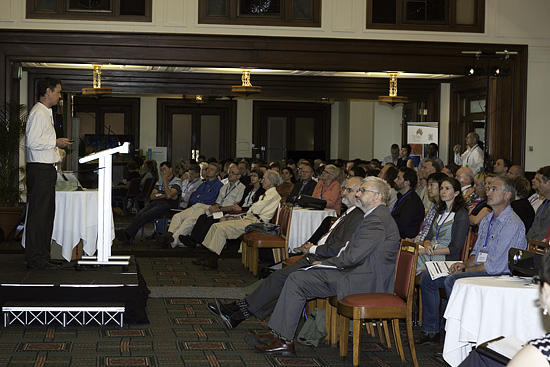Lord Robert May addresses the delegates to the TERN symposium
If we are serious about understanding the structure and function of ecosystems, we need to change our focus, away from the cute or cuddly animals to the creepy crawlies of the Earth—the insects, invertebrates and micro-organisms.
Giving the opening plenary address of the TERN symposium this morning, Lord Robert May, of Oxford University, told the 350 delegates that understanding how all the components of ecosystems function and interact was essential for predicting accurately how they are likely to react to disturbances, including those caused by human activity.
The presence and activities of all species have implications for ecosystem services. The Millennium Ecosystem Assessment published in 2005 identified 25 categories of normal ecosystem interactions that underpin human health and vitality, from giving us food and medicine, to regulating the environment (e.g. cleaning water), to aesthetic and recreational enjoyment.
‘Of the 25 categories, 15 show signs of serious damage, four are in pretty good heath–they are mostly to do with-food production – and six we don’t know enough about to judge,’ Lord May says.
He said TERN was an ‘extraordinarily timely intervention’ because it was in a position to help coordinate the spread of collaborative research.
‘It is hugely important that these things be coordinated and shared, with collegiality and cooperation fostered,’ he says.
‘One of the things TERN has to do – and is doing well – is not only to look forward but also to look backwards. There is a lot to learn by looking at history.’
Along with TERN in Australia and the National Ecological Observatory Network (NEON) in the United States, the United Kingdom had also set up National Biodiversity Network (NBN).
‘The NBN is made up of public, voluntary and commercial sectors, and 80 million databases. However, something like two-thirds of these are about birds. We focus on things that have emotional resonance with us. It’s understandable, but we have to raise the money to look at the full spectrum,’ Lord May says.
He charged TERN with being at the forefront of bringing about this sea change in the focus on ecological research.
‘We need continual thought about what areas people are working on, so we don’t end up in the ridiculous position of all working on mammals and birds.’
Following Lord May’s plenary address, TERN’s two Associate Science Directors, Professor Stuart Phinn and Professor Andy Lowe, responded to this challenge.
Andy said that that ecosystem services had been valued at 30 trillion dollars a year, which is twice the gross domestic product of all nations, and underlined the importance of moving conservation beyond a ‘bleeding-heart cause’ to make strong economic arguments to conserve and wisely use our biodiversity.
Stuart said: ‘Building TERN has been about putting together a jigsaw puzzle, and a lot of the pieces were already there: Australia’s ecosystem science community has already undergone a transformational change.
‘The scope of activities that emanate around science activity is large, and covers non-profits, industry, government, community.’
‘TERN, being focused on terrestrial systems, can act as an instigator, linking with the Atlas of Living Australia (ALA), AuScope and the Integrated Marine Observing System (IMOS).’
‘The questions driving TERN are also driving international science.’
Andy said that TERN had progressed to the stage where it could feed into international reporting on biodiversity by the Intergovernmental Platform on Biodiversity and Ecosystem Services (IPBES), which was established last April.
All presentations made at the TERN science symposium will be available via the TERN web site after the symposium.
Published in TERN e-Newsletter February 2013 special symposium issue

Professor Andy Lowe giving a plenary address on Tuesday morning







